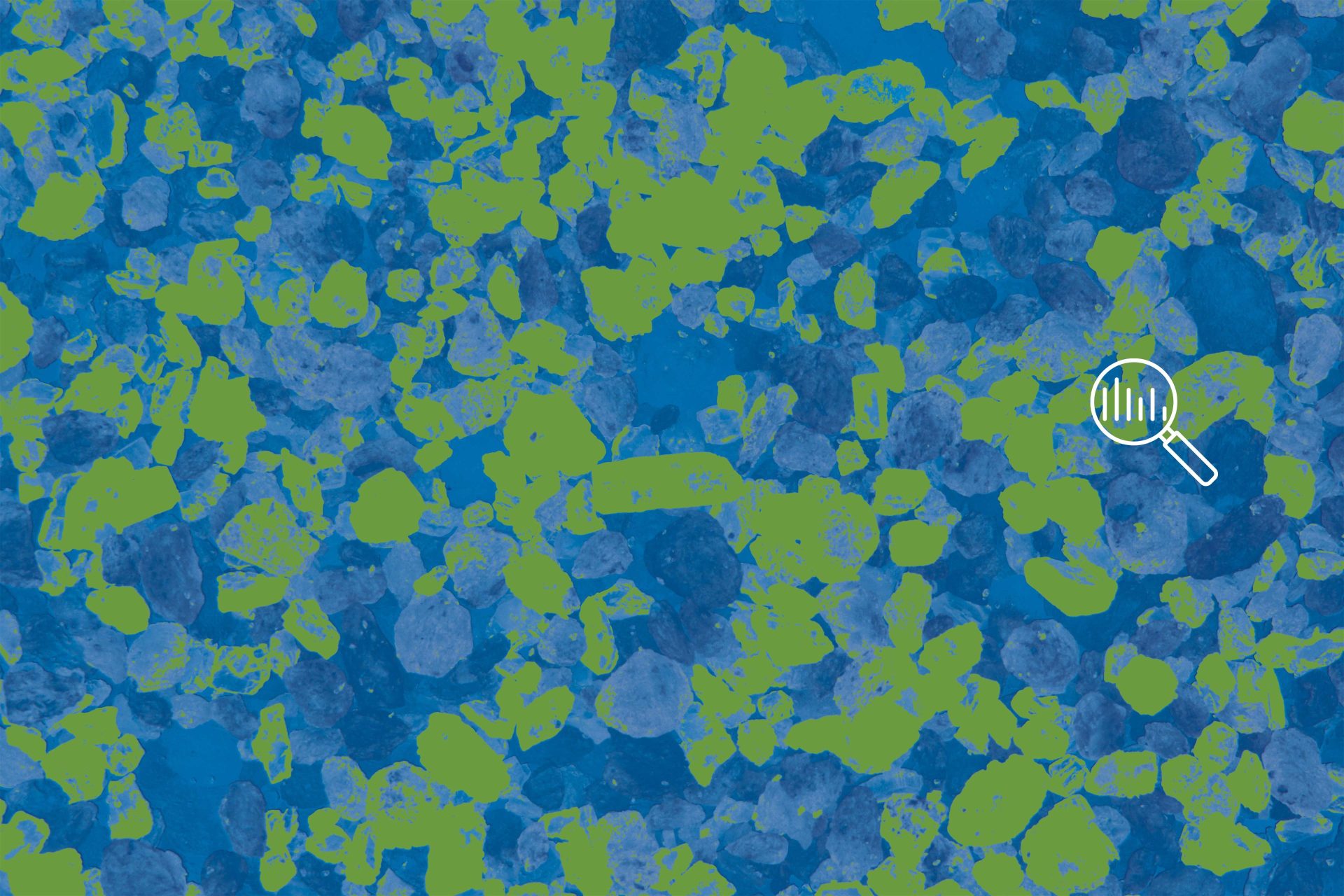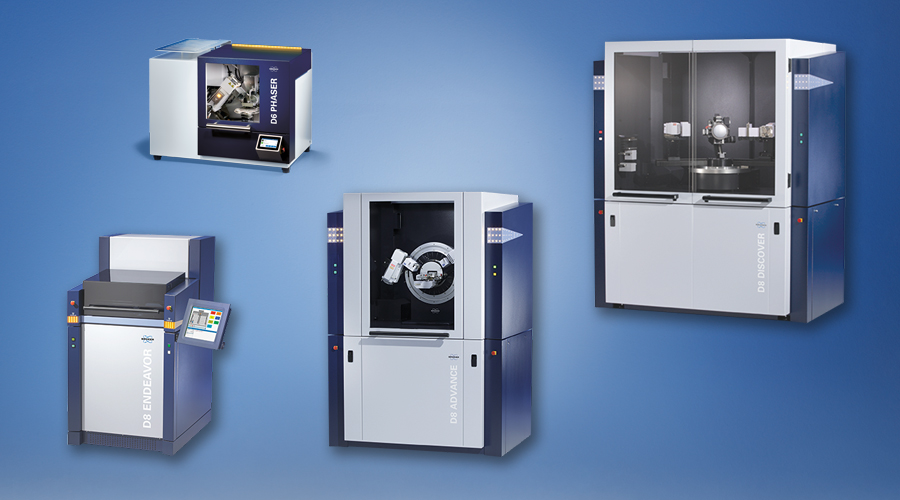

DIFFRAC.EVA
General Scan Evaluation
Routine data and cutting-edge research
The Swiss Army Knife of the X-ray Diffractionist
DIFFRAC.EVA provides tools for the quick analysis of one- and two-dimensional diffraction data. It supports all Bruker detectors and XRD scan types. The EVA functionality covers a broad analytical spectrum from data reduction, basic scan evaluation and presentation, detailed peak analysis, phase identification and quantification, to the determination of crystallinity and crystallite size.
EVA interfaces with all relevant databases for phase identification and may additionally use crystal structures and complementary chemical composition information from e.g. XRF based chemical analysis for its award-winning species dentification.
Furthermore, DIFFRAC.EVA supports the efficient evaluation of big data that originate from today’s fast detectors, the use of in-situ environments, high-throughput screening or spatially resolved measurements. The software provides specific chart types, but also advanced chemometrics tools for cluster analysis and pattern-matching based crystalline and amorphous species identification and quantification.
It fully supports conventional file-based tasks but also integrates the DIFFRAC.SUITE database infrastructure for daily work, even in controlled environments as required by the 21 CFR Part 11 regulations for the pharmaceutical industry.
Finally, DIFFRAC.EVA is used for the preparation of publication ready graphs and user specific reports, either directly in EVA or using the DIFFRAC.SUITE RESULTS-MANAGER and the instrument database.
Introducing Enhanced Functionality - Discover the Power of EVA's New Features in Version 7
Effortless PDF generation: We are proud to present the results of a collaboration with Prof. Olivier Masson from the University of Limoges, an expert in the field of PDF analysis. Utilizing his expertise, DIFFRAC.EVA now includes the powerful PyTSRedX algorithms for generating experimental PDFs from raw diffraction data. Entry into PDF analysis has never been this simple: with just a few clicks, users can quickly and painlessly create high-quality PDFs. DIFFRAC.EVA automatically corrects for background and Compton scattering, absorption, polarization, and X-ray fluorescence, then normalizes and Fourier transforms the data, all within seconds!
Export the experimental PDF for further quantitative evaluation in DIFFRAC.TOPAS and explore new horizons in X-ray data evaluation of amorphous materials, nanoscopic structures, or local effects in disordered structures.
Effortlessly repeat previously recorded commands with the power of workflows. Record a sequence of EVA commands and replay them at any time. During the recording process, only applicable commands are enabled. The workflow runner control displays context-sensitive workflows, showing only those actions that start with a command relevant to the current selection. Instantly start a workflow using the convenient drop-down list in the toolbar. Modify command parameters within pre-recorded workflows using the edit button.
The benefits of workflows in DIFFRAC.EVA are:
- Increased Efficiency: Workflows allow users to record and replay a sequence of commands, saving time and effort in executing repetitive tasks. By automating complex or frequently performed operations, workflows streamline the analysis process and enhance overall efficiency.
- Consistency and Reproducibility: Workflows ensure consistency and reproducibility in data analysis by capturing the exact sequence of commands used during a specific analysis. This feature is particularly valuable when working on collaborative projects or when revisiting previous analyses.
- Error Reduction: With workflows, there is a reduced risk of human error during data analysis. Since recorded workflows execute predefined commands accurately, the likelihood of mistakes or omissions is minimized, leading to more reliable and trustworthy results.
- Simplified Operation: Workflows simplify the execution of complex analysis procedures by breaking them down into a series of manageable steps. Users can execute the entire workflow with a single click, eliminating the need to remember and execute multiple commands manually.
- Flexibility and Customization: Workflows offer flexibility and customization options to suit individual analysis requirements. Users can modify and fine-tune recorded workflows by adjusting parameters, allowing for adaptability and tailoring to specific analysis needs.
- Streamlined Collaboration: Workflows facilitate collaboration among researchers by providing a standardized approach to data analysis. Recorded workflows can be easily shared with team members, ensuring consistency across multiple users and enabling seamless collaboration on projects.
Overall, the use of workflows in DIFFRAC.EVA provides users with improved efficiency, enhanced accuracy, reproducibility, and collaboration capabilities, resulting in a more streamlined and productive data analysis experience.
DIFFRAC.EVA brings significant advancements to pattern fitting capabilities, enhancing the accuracy and reliability of your analyses. Benefit from improved algorithms, faster performance, and more stable results.
- Refinement of Lattice Parameters: Achieve higher precision and accuracy in our new lattice parameter refinement with the addition of offset and sample height corrections.
- Preferred Orientation and Intensity Fitting: Explore advanced features such as the March-Dollase model and spherical harmonics up to the 6th degree for preferred orientation corrections. Conduct peak height fits without constraints using a Pawley-like approach. The replacement of pseudo-Voigt peaks with Voigt peak-shape function and Pearson VII further enhances profile fitting, resulting in better micro-structure evaluations.
- Improved Emission Profile: Enhance the clarity and assign minor signals accurately within the total fit by including spectral impurities such as K-beta and tungsten lines in the K-alpha spectrum. This feature improves the unambiguous identification of signals and provides a more comprehensive analysis of your X-ray data.
- Quantitative Analysis and Amorphous Phases: Perform semi-quantitative analysis using options like the Reference Intensity Ratio (RIR) for the highest peak or all fitted peaks. Add one or more amorphous "phases" easily using the dedicated buttons in the "Amorphous Phases" tab.
- Analysis of the microstructure: Deconvolution of the experimentally determined instrument resolution from your scan data using the double-Voigt approach now allows quantitative analysis of crystallite size and microstrain from the entire diffraction pattern, while still allowing the Scherrer equation to be applied to individual peaks.
- Reporting: Numerical fit results and residual plots can be easily transferred to the internal Electronic Lab Notebook. A new formatting toolbar has been added to the Lab Notes view to provide text formatting options
With these enhancements, DIFFRAC.EVA empowers you to achieve more accurate and meaningful results, enabling advanced pattern fitting and comprehensive analysis of your X-ray data.
Expanded Data Accessibility and Management: Access raw data from PDF-4 databases using the well-known Search/Match functionality in EVA, effortlessly extracting original scan data for further evaluation.
Furthermore, leverage the capabilities of user databases by including your own measured patterns, enabling you to store reference measurements and other valuable data alongside your analysis results. Utilize these user databases as reference inputs for Cluster Analysis, Positive Materials Identification (PMI), or the powerful semi-quantitative pattern matching (SQUALL) feature. By combining User Databases and Pattern Matching, you can perform advanced analysis and comparison of your patterns, enhancing the accuracy and depth of your X-ray data evaluation. With improved data accessibility, comprehensive management options, and advanced pattern matching capabilities, DIFFRAC.EVA empowers you to streamline and elevate your X-ray data analysis process.
DIFFRAC.EVA Key Features at a Glance
Data Reduction, Visualization and Manipulation
DIFFRAC.EVA is the software of choice to get a first impression of the measurement. An important step is the data reduction from one or several snapshot images of steady detectors or re-binning the pixels from a scanning 2D detector into conventional 1-dimensional XRD data. EVA provides the well-established tools to further analysis of those 1D data. This ranges from routine signal processing to scan arithmetics and more advanced techniques to look at individual peaks and complete scans.
Big Data Visualization and Feature Extraction
Cluster analysis in EVA provides deeper understanding and intuitive presentations of large X-ray data sets.
The cluster analysis tool is an adaption of the well-known Polysnap software. It assists in the identification of known and unknown samples, analyzes mixtures, outliers, and assists in quality control. It is used for high-thoughput screening but also for analyzing non-ambient data.
DIFFRAC.EVA – Cluster analysis, 3D MMDS view
Metric multi-dimensional scaling is a way to represent cluster analysis data graphically in 3D. EVA also offers PCA plots and up to 6-dimensional charts for visualizing additional information.
Large Data Sets and Supplementary Information
The multi-scan reader quickly loads hundreds of scans and provides a simple overview in a two-dimensional representation. Outliers in regular quality control measurements are easily spotted and specific scans worth a detailed examination can be extracted from reciprocal space maps or series of non-ambient or in-operando measurements.
Supplementary scan information such as measurement position, temperature, humidity, charge states, or even intensity of an individual peak or the amount of amorphous background can be visualized in the side-view. Again, this assists in finding scans of interest for the further examination of phase transformations, the decomposition or formation of phases.
BRAGG2D
A simple way of monitoring sample morphology (i.e. spottiness due to uneven grain size, texture or preferred orientation because of alignment of crystallites in the specimen holder) is achieved by utilizing the large beam footprint and the high resolution of the Bragg-Brentano geometry in combination with asymmetric 1D detection using the LYNXEYE detector family. DIFFRAC.EVA is used to visualize those data and to select individual scans for further detailed inspection.
Phase Analysis
Since its first release, EVA's search/match module is generally appreciated as the most reliable and most accurate tool for phase identification. Correspondingly, EVA performed best in an international Search-Match Round Robin (Le Meins et al., 2002, www.cristal.org/smrr). Since then numerous improvements have further differentiated EVA from conventional software for phase analysis
- Highly sophisticated residual search with respect to already identified phases, thus greatly improving analysis of minor phases
- Support of Variable Counting Time (VCT) and Dynamic Beam Optimization (DBO) data for highly accurate trace phase analysis thanks to significantly decreased Lower Limits of Detection (LLoD)
- Simultaneous search in multiple reference databases, such as the ICDD PDF2/PDF4+/PDF4 Minerals/PDF4 Organics databases
- Grouping of candidate patterns phases to handle the ever-increasing number of similar or nearly identical reference database entries
- Phase identification and accurate quantitative phase analysis based on RIR (reference intensity ratios) values
DIFFRAC.EVA Advantages
- Complete collection of the best algorithms for data integration and evaluation
- Innovative design and operation concept for maximum simplicity and flexibility.
- It takes full advantage of modern computers and operating systems like multi-threading, dedicated parallelization, native 64-bit support
- Real-Time-Preview of all evaluations for visual validation
- Reversing an action? No problem! EVA allows to undo and redo
- Highly flexible GUI adapts to the available user hardware, best operation practices and requirements of the various software modules
- Customization to user preferences for individual window layouts, column configurations and screen settings
- High level of integration with the DIFFRAC.SUITE Measurement and Results Manager software
- An extensive step-by-step tutorial makes EVA easy to use from the very beginning.
DIFFRAC.EVA Specifications
| Version | The current version of the software is DIFFRAC.EVA V7, DIFFRAC.Part 11 V8 | |
Database compatibility | Version 8.7 and two versions backwards compatible for r/w access | |
Compliance | cGxP/21CFR Part 11 |
DIFFRAC.EVA Resources
Flyers & Articles & Product Sheets & White Papers
Keep your DIFFRAC.EVA up to date
Free Maintenance Update
The free DIFFRAC.EVA Maintenance Update renews your EVA version to the most recent release. Regardless of your EVA license level, you can always download the latest Maintenance Update from www.brukersupport.com, free of charge!
Download process
- Register at Bruker Customer Support
- Click on the "Software" button
- Search for the DIFFRAC.EVA Maintenance Update
- Download the update
Bugfixes
By keeping your DIFFRAC.EVA up to date, you will benefit from all bugfixes made for the current but also all previously released versions, regardless of the license level. DIFFRAC.EVA Maintenance Updates are cumulative and can therefore be applied to any previous version.
What are Upgrades?
DIFFRAC.EVA Maintenance Updates do not come with new features. If you want to benefit from features introduced in new major releases you need to purchase the latest DIFFRAC.EVA upgrade.

